GIGABYTE AM1M-S2H Review: What Can $35 Get You?
by Ian Cutress on August 15, 2014 3:00 PM EST- Posted in
- Motherboards
- AMD
- Gigabyte
- Kabini
- AM1
GIGABYTE AM1M-S2H In The Box
Despite all the talk earlier in the review about how low cost motherboards and the motherboard manufacturers are dealing with extremely low margins, imagine developing a motherboard for that budget then being told that some extras have to be put into the box. Now I admit the usual extras we get in the box (SATA cables, IO shield) are bought in immense bulk, but even these have a tangible bill-of-materials cost, even if it comes in at a few cents each. If one SATA cable cost 3.5 cents, that is 0.1% of the cost – double if two are added. I suspect that the thick, multi-language manuals cost north of $0.50 each to produce as well, so this might be stripped down to compensate. When margins are quibbling over cents, we should not expect many extras.
In the AM1M-S2H, we get the following:
Manual
Driver Disk
Rear IO Shield
Two SATA Cables
As expected, not much but enough to get a user started if purchasing OEM storage/ODD.
Many thanks to...
We must thank the following companies for kindly providing hardware for our test bed:
Thank you to OCZ for providing us with PSUs and SSDs.
Thank you to G.Skill for providing us with memory.
Thank you to Corsair for providing us with an AX1200i PSU and a Corsair H80i CLC.
Thank you to MSI for providing us with the NVIDIA GTX 770 Lightning GPUs.
Thank you to Rosewill for providing us with PSUs and RK-9100 keyboards.
Thank you to ASRock for providing us with some IO testing kit.
Test Setup
| Test Setup | |
| Processor |
AMD Athlon 5350 Quad Core, 2.05 GHz |
| Motherboards | GIGABYTE AM1M-S2H |
| Cooling | Stock Cooler |
| Power Supply | OCZ 1250W 80 PLUS Gold |
| Memory | ADATA XPG V1.0 2x8GB DDR3L-1600 9-11-9 |
| Memory Settings | XMP |
| Video Cards | MSI GTX 770 Lightning |
| Video Drivers | NVIDIA 337.88 |
| Hard Drive | OCZ Vertex 3 240 GB |
| Case | Open Test Bed |
| Operating System | Windows 7 64-bit SP1 |
| USB 2/3 Testing | OCZ Vertex 3 240 GB |
System Benchmarks
Power Consumption
Power consumption was tested on the system while in a single MSI GTX 770 Lightning GPU configuration with a wall meter connected to the OCZ 1250W power supply. This power supply is Gold rated, and as I am in the UK on a 230-240 V supply, leads to ~75% efficiency > 50W, and 90%+ efficiency at 250W, suitable for both idle and multi-GPU loading. This method of power reading allows us to compare the power management of the UEFI and the board to supply components with power under load, and includes typical PSU losses due to efficiency. These are the real world values that consumers may expect from a typical system (minus the monitor) using this motherboard.
While this method for power measurement may not be ideal, and you feel these numbers are not representative due to the high wattage power supply being used (we use the same PSU to remain consistent over a series of reviews, and the fact that some boards on our test bed get tested with three or four high powered GPUs), the important point to take away is the relationship between the numbers. These boards are all under the same conditions, and thus the differences between them should be easy to spot.
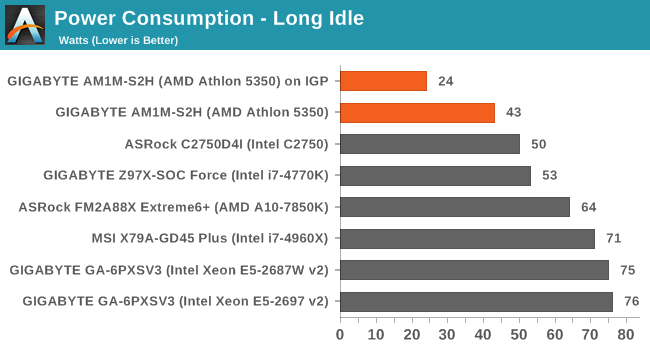

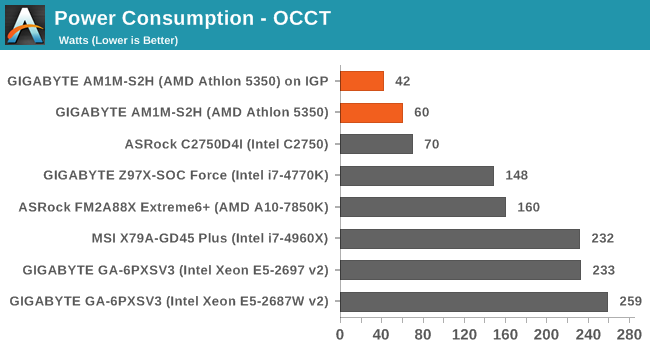
Being at the low end of the efficiency bell curve rockets our power consumption numbers, but for comparison to other platforms we have to remain consistent. Nevertheless, at full CPU load the increase in power consumption is only 17-18W. Perhaps surprisingly is the extra power consumption with the GPU installed.
Windows 7 POST Time
Different motherboards have different POST sequences before an operating system is initialized. A lot of this is dependent on the board itself, and POST boot time is determined by the controllers on board (and the sequence of how those extras are organized). As part of our testing, we look at the POST Boot Time using a stopwatch. This is the time from pressing the ON button on the computer to when Windows 7 starts loading. (We discount Windows loading as it is highly variable given Windows specific features.)

Low cost platforms are not targets for POST Time optimization, so anything under 20 seconds should be reasonable. The lack of controllers on low cost platforms should help POST times in that regard as well.
Rightmark Audio Analyzer 6.2.5
Rightmark:AA indicates how well the sound system is built and isolated from electrical interference (either internally or externally). For this test we connect the Line Out to the Line In using a short six inch 3.5mm to 3.5mm high-quality jack, turn the OS speaker volume to 100%, and run the Rightmark default test suite at 192 kHz, 24-bit. The OS is tuned to 192 kHz/24-bit input and output, and the Line-In volume is adjusted until we have the best RMAA value in the mini-pretest. We look specifically at the Dynamic Range of the audio codec used on board, as well as the Total Harmonic Distortion + Noise.
Dynamic Range of AM1M-S2H
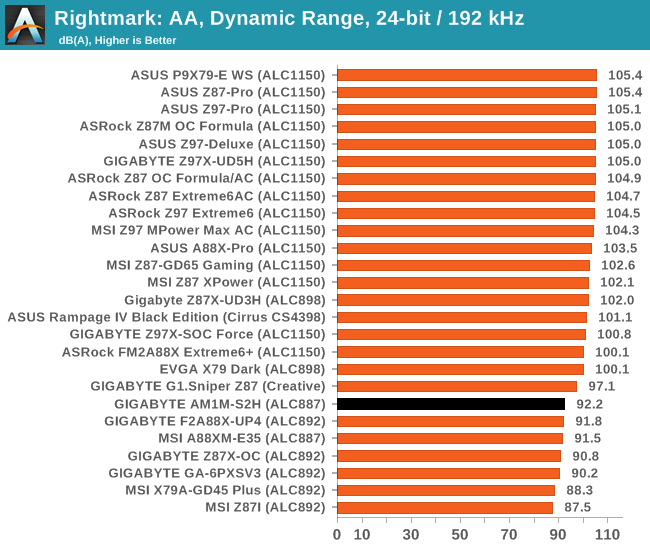
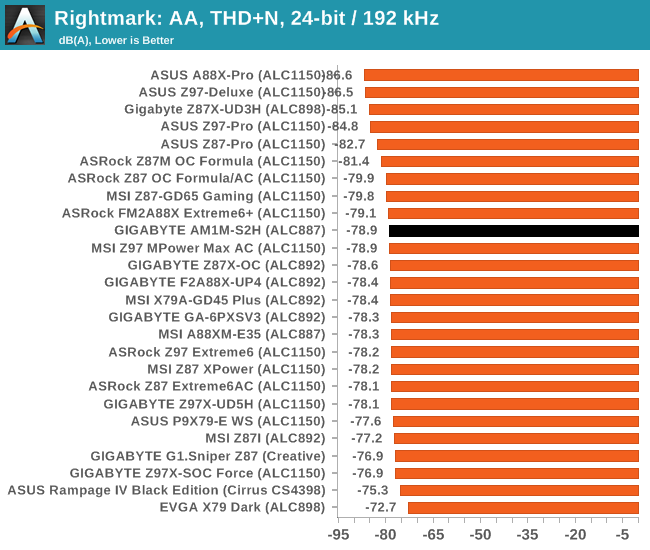
92.2 dBA is pretty much ball-park for an ALC887.
USB Backup
For this benchmark, we transfer a set size of files from the SSD to the USB drive using DiskBench, which monitors the time taken to transfer. The files transferred are a 1.52 GB set of 2867 files across 320 folders – 95% of these files are small typical website files, and the rest (90% of the size) are small 30 second HD videos. In an update to pre-Z87 testing, we also run MaxCPU to load up one of the threads during the test which improves general performance up to 15% by causing all the internal pathways to run at full speed.
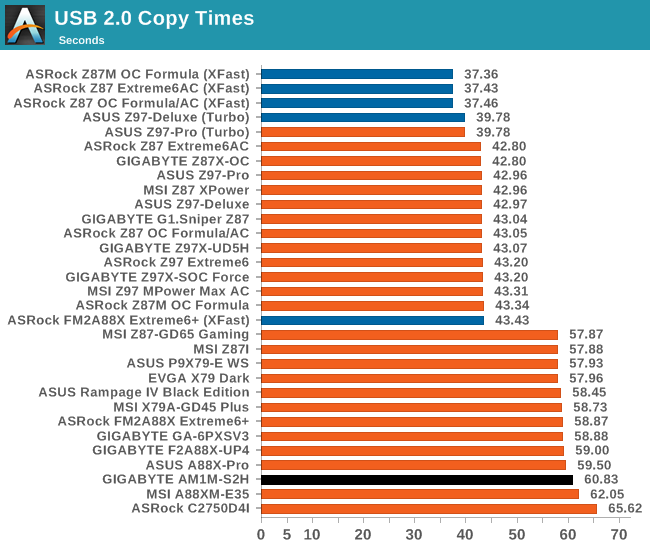
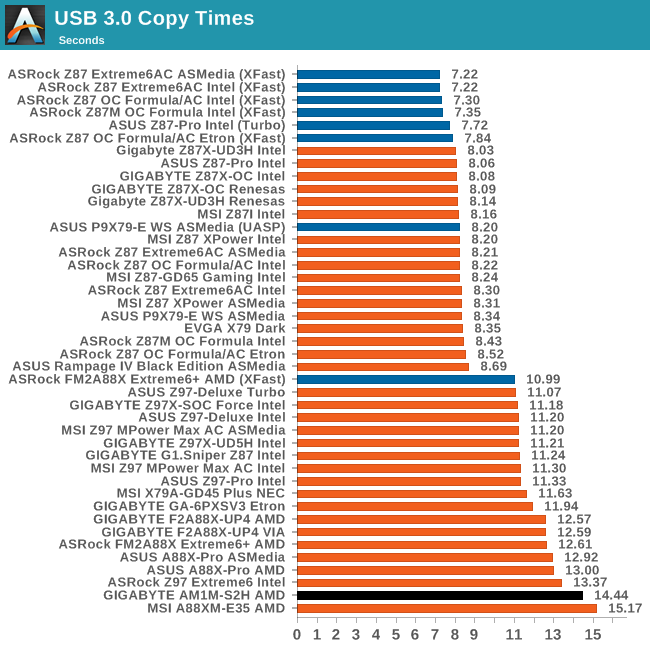
One would imagine that USB speed should be constant across any platform, especially when the standard used and base frequencies for the pathways are the same. We have seen in the past that the CPU used can have a difference in USB copy times, as well as the memory, but we try and negate that by loading up one thread during the test. For USB copy times the AM1 platform, while slower than the rest, does not perform too badly overall.
DPC Latency
Deferred Procedure Call latency is a way in which Windows handles interrupt servicing. In order to wait for a processor to acknowledge the request, the system will queue all interrupt requests by priority. Critical interrupts will be handled as soon as possible, whereas lesser priority requests such as audio will be further down the line. If the audio device requires data, it will have to wait until the request is processed before the buffer is filled.
If the device drivers of higher priority components in a system are poorly implemented, this can cause delays in request scheduling and process time. This can lead to an empty audio buffer and characteristic audible pauses, pops and clicks. The DPC latency checker measures how much time is taken processing DPCs from driver invocation. The lower the value will result in better audio transfer at smaller buffer sizes. Results are measured in microseconds.

One of the good things about DPC Latency is that it seems to have become a generational improvement rather than one relying on a fast platform. It seems that the newer the platform in general, the better the DPC Latency. While 201 microseconds is on that 200 boundary we like to distinguish at the high end, compared to some bad results we have had in the past, this is great.


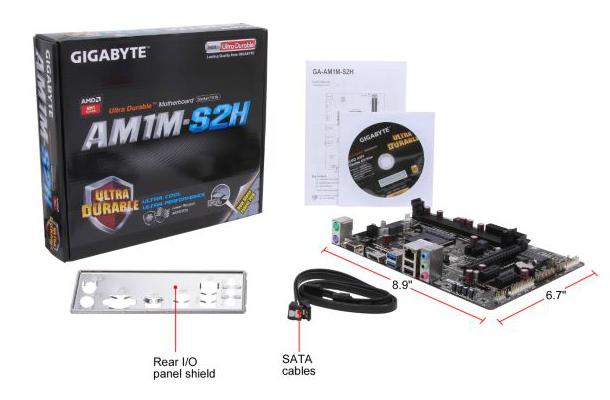









45 Comments
View All Comments
fteoath64 - Sunday, August 17, 2014 - link
Yes and something different as well like the Asrock AM1 board that had a DC 19v input as well as 24pin psu connector but using the DC input instead!. This is where a cheap or sometimes existing adaptor block is already available for use and being used. Now that would be different. AM1 cpu is disappointing in total cost as BayTrial is way cheaper giving similar performance (though lesser a bit) at half the power consumption as AM1.jospoortvliet - Monday, August 18, 2014 - link
Every review I have seen shows the AM1 performance better per watt than the atoms, as AM1 idle usage is lower and performance is better.... but I have seen only a few. Care to link me to one showing the atom has higher performance and lower idle use than the AM1? Load performance matters little, as in typical usage you load these systems .5% of the time...jabber - Friday, August 15, 2014 - link
Used a lot of Gigabyte boards with Dual BIOS over the years.....never used it.bebimbap - Saturday, August 16, 2014 - link
I thought that dual bios might be marginal benefit of dual bios was nothing till one day I decided to change my Cpu from a k series to non-k. I reset the bios in between but it still became corrupted. Though I have other methods of recovvering from this, the board auto recovered and copied the second bios over the first. In the last eight years and over a dozen systems I have only encountered this once and it saved me time. If it were my only system it would have been much worse if I didn't have dual bios. Also I can imagine this happens to reviewers who test multiple chips on multiple boards and with multiple settings. I can see it now: "We would have loved more time on this board but, it's bios failed and we had other boards to review."HardwareDufus - Friday, August 15, 2014 - link
I look at this system and I think: $50 120GB SSD, $35 MB, $30 CPU, $50 4GB DDR2...Perfect drop in replacement for ancient PII or AMD K6 systems..... $170..... reuse your existing case, powersupply, keyboard, mouse, monitor.. Sell the old stuff (harddrive, cpu, motherboard, memory) for $20 to somebody. Your out like $150.... and you've got a cheap SSD... It will boot fast and feel fast relative to what you had...
jabber - Friday, August 15, 2014 - link
Is anyone really running such systems? It's pretty rare I get a single core box older than 2004 dropped in to me nowadays. 20th century computing is pretty much extinct.wintermute000 - Saturday, August 16, 2014 - link
Its indeed a cheap system, but what person who knows how to build a PC, is still using something that old and worthless. The bother + risk on ancient PSU = just throw that PII/III away, but a new box. Which may very well be a cheapie with a 5350, but I don't think system building comes into it in any way shape or form.jabber - Saturday, August 16, 2014 - link
Mmm yes running your new hardware off a 15 year old PSU and yellowed beige plastic PC case...like that'll work.A system to be proud of.
HardwareDufus - Saturday, August 16, 2014 - link
Although I am Irish/American, I have lived 8 1/2 years in Mexico. So yeah.... $170 to build a system, even if it has an old powersupply and a beige case is a fantastic idea. You need to understand just how much of the world's population lives on the edge of poverty.I personally am an odd one because I build a new Mini-ITX rigs for myself about every 2 years. The last was with an 3770K, IGP for video on 2 24" LCD 1920X1200 monitors. (No discreet video cards for me)... SSD and 16GB of ram.... and I spend too much in the process each time.
However, I truly see the value in recycling old stuff... everytime I build a new system... I pass on the old stuff. I know of an elderly couple in upstate NY that is still using my AMD k6-III+ build overclocked to 600Mhz with 768MB of Ram on Windows2000 Professional with Office2000 Professional. THey turn the computer on... then go start brewing coffee... Eventually the coffee and the computer are ready. There was a time when I was buying up every K6-III+ I could find on EBay, overclocking them to upgrade ancient Socket7 machines for people for almost Zero money.
My old Server machine with Dual PIIs overclocked to 400Mhz (B21 tape trick), 1GB of Ram and 4 4GB UWSCSI drives is still running (WinXP Pro) at another person's house. What a ridiculous machine to surf the web and check email... but I passed it on for free!
Last year I purchased 13 Dell Optiplex755s with 13 Planar 18" LCDs (1280X1024) at less than $120usd a piece. These boxes all had leagal copies of WIndows7 Professional. Yeah, they've only got 2GB of Ram... and 40GB harddrives.... but they are perfect for teaching Physical Computing with Arduino microcontrollers..
Nothing like putting 13 PCs on a couple of plastic coca cola tables and connecting them up to a single 16port Netgear switch and uplinking to your 5mbs DSL that cost you $349mxn a month (About $30usd) and letting folks check email, surf, learn to use Google Docs... learn to program in C/C++ using Arduino software and $15 microcontrollers...All for free.
I grab up all of the obsolete netbooks I can find with WindowsXP on them.... stick on Arduino Software and Adobe Reader... Stick on a bunch of downloaded PDFs on Basic Electronics, C Programming with Arduino in Spanish, etc... and put it all a plastic OXXO (think SevenElven) with an Arduino UNO clone microcontroller, usb cable, handfull of LEDs and Resistors.... and send them off with young people. Too slow for browsing content on the internet kids shouldn't be browsing... but more than they need to learn programming and electronics.
I know a poor family that is using the composite video of the Rasberry Pi (overclocked to 1Ghz) hooked up to their old TV using a usb keyboard, mouse and 2GB microSD to surf the internet and check mail. Cost me $25usd to gift that to them (keyboard, mouse and coax were freebies I got). (I have 2 rasberry pi...I haven't found a thing to do with them excpet to show off really slow $25 computers)..
Yes, I'd rather be handing out Surface 3 Pros to everyone... But in the meantime... $30 cpus, $35motherboards and $50SSDs..... that's good stuff. Cheap SSDs can make the slowest system feel adequate!!
jabber - Saturday, August 16, 2014 - link
I put far newer stuff than that in the trash. There comes a point in the civilised world where it just becomes a liability and a dust trap.